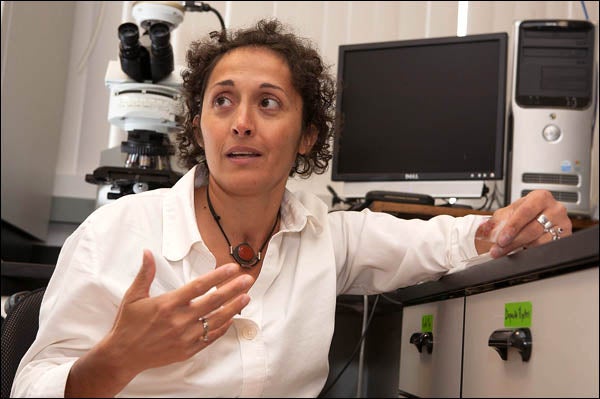‘EXCITING TIME’
Protein could help save tissue following heart attack

East Carolina University physiology professor Dr. Jitka Virag received grant funding for ongoing research into a protein that helps reduce tissue damage during heart attacks. (Photo by Cliff Hollis)
Research by an East Carolina University scientist could lead to a product that helps preserve heart tissue during a heart attack.
Dr. Jitka Virag, an assistant professor of physiology at the Brody School of Medicine at ECU, and collaborators are working with a protein called ephrinA1. They have found that an injection of the protein into a rodent heart at the onset of a myocardial infarction, commonly referred to as a heart attack, reduces the death of heart tissue by as much as 50 percent. Their work was published last year in the Journal of Physiology.
“If it works in the acute and chronic models and ultimately reduces the progression of heart failure and mortality, I think the potential for therapeutic use is great,” Virag said.
She recently received a $75,000 grant from the N.C. Biotechnology Center to further her research. She hopes that will clarify how the protein works to protect heart tissue and whether it can be developed into a viable therapy for people who have had heart attacks.
Technically, a myocardial infarction is caused when the blood supply to the heart is blocked, usually by a break-up of plaque inside the artery. At worst, death occurs, but in almost all cases, tissue dies, and the heart loses part of its capacity to pump blood. If caught early, damage can be minimized. However, clinical therapies now available to limit the progression to heart failure are geared toward relieving the symptoms, not repairing the injury.
Ephrins are a type of protein known as receptor tyrosine kinase ligands that regulate certain cellular processes. In particular, the ephrinA1 ligand is angiogenic, meaning it can create blood vessels. Due to that property and others, Virag hypothesized that ephrinA1 would help reduce tissue damage. It did, but not because of its angiogenic properties.
Thus, Virag and her team are now working to determine why ephrinA1 works, the degree of protection it provides in acute and chronic reductions in blood flow, whether the initial protection is lasting and preserves cardiac function in the long term, and the effects of other conditions such as diabetes on the protective capacity.
ECU is pursuing a patent on the discovery and could eventually work with a biotechnology firm or pharmaceutical company to commercialize it.
“Although preliminary data from ongoing experiments is quite promising, there are many questions that remain unanswered, and so this is an exciting time for this work,” Virag said.